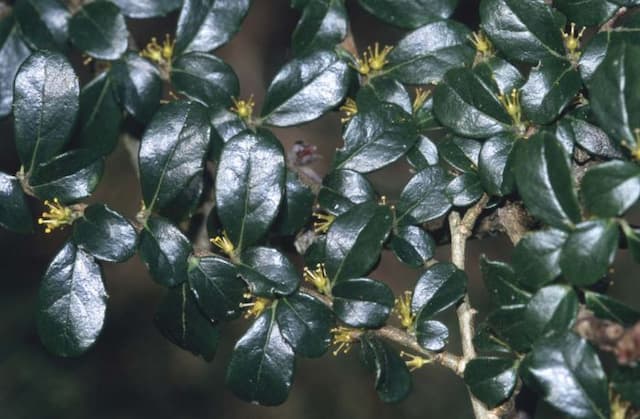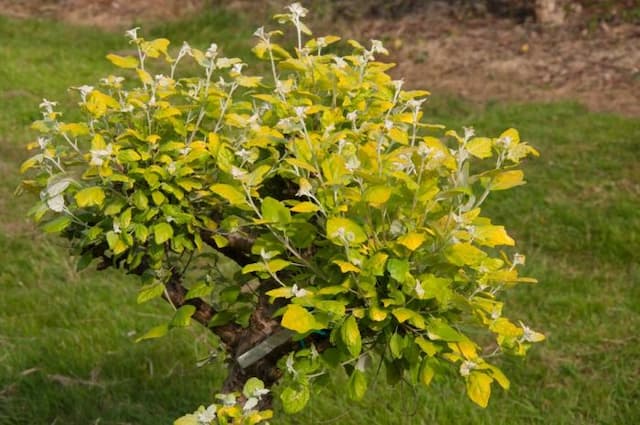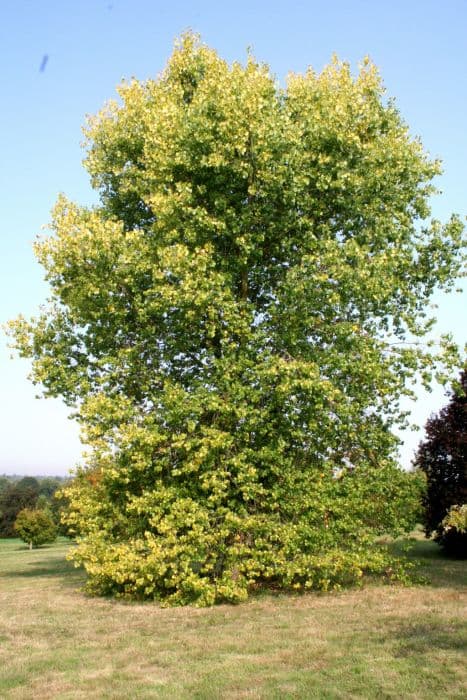Farges Willow Salix fargesii

ABOUT
The plant in question is commonly known as Farges Willow. It is a deciduous shrub that is renowned for its striking ornamental features. The appearance of Farges Willow is characterized by its elegant branches that bear narrow, elongated leaves with a lush, green coloration on the upper surface and a lighter, sometimes whitish or bluish-green hue on the undersides. These leaves tend to have a slightly glossy finish and may exhibit a fine texture with subtle veining. During the blooming period, Farges Willow produces catkins, which are cylindrical flower clusters that add a decorative appeal to the plant. These catkins are typically accompanied by a plush, silky texture that shifts in color as they mature, starting with softer hues and often transitioning to a more prominent coloration as the season progresses. The bark of the Farges Willow also contributes to its visual interest. It often displays an alluring color that might vary among individual plants, tending to exhibit shades that can range from grays to browns. The bark texture is typically rugged, with furrows and ridges that become more pronounced as the plant ages, providing a striking contrast to the smooth, slender appearance of the younger stems. In addition to its visual properties, the overall shape of Farges Willow is also a key aspect of its appearance, often described as having a graceful and refined structure that may assume various forms, influenced by pruning and the environment in which it grows. Its branching pattern creates a distinctive silhouette that is easily recognizable, especially in the winter months when the leaves have fallen, and the intricate framework of the branches is fully visible.
About this plant
 Names
NamesFamily
Salicaceae
Synonyms
Farges Willow, Chinese Violet Willow
Common names
Salix fargesii.
 Toxicity
ToxicityTo humans
Salix fargesii, commonly known as the Farges willow, is not typically known for being toxic to humans. In general, willows contain salicin which is a precursor to aspirin, but they are not commonly associated with poisoning when touched or ingested in small quantities. If someone were to consume large amounts of the bark or leaves where salicin concentration is higher, they might experience symptoms similar to aspirin overdose which could include stomach pain, nausea, vomiting, or diarrhea. It is always best to consult with a medical professional if ingestion occurs and there is concern about possible toxicity.
To pets
Farges willow is generally considered to be non-toxic to pets. As with humans, willow trees contain salicin, but it typically does not cause harm to animals when consumed in small amounts. However, if a pet were to ingest large quantities, they might exhibit signs of aspirin-like toxicity, which includes vomiting, diarrhea, or other signs of gastrointestinal upset. In severe cases, more serious symptoms like kidney dysfunction or neurological effects could potentially occur. If a pet owner suspects their animal has ingested a large amount of the plant and is showing symptoms of distress, it is recommended to consult with a veterinarian.
 Characteristics
CharacteristicsLife cycle
Perennials
Foliage type
Deciduous
Color of leaves
Green
Flower color
Yellow
Height
20 feet (6 meters)
Spread
15 feet (4.6 meters)
Plant type
Tree
Hardiness zones
6
Native area
China
Benefits
 General Benefits
General Benefits- Erosion Control: Salix fargesii, commonly known as Farges Willow, has extensive root systems which are effective in stabilizing soil and preventing erosion, particularly along riverbanks and slopes.
- Wildlife Habitat: Provides food and shelter for various species of birds, small mammals, and insects.
- Aesthetic Appeal: With its attractive bark, foliage, and catkins, Farges Willow is often used in ornamental landscaping to enhance visual interest in gardens and public spaces.
- Windbreak: Its dense growth habit makes it suitable for use as a windbreak, offering protection to nearby crops and structures from strong winds.
- Shade Provider: Can create shaded areas in gardens and parks, making it a valuable plant for creating cooler, sheltered spaces in hot climates.
- Soil Improvement: As it sheds leaves and branches, it contributes to soil fertility through the decomposition of organic matter.
- Fast Growth: It grows rapidly, providing quick establishment and results for landscaping projects and reforestation efforts.
 Medical Properties
Medical PropertiesThis plant is not used for medical purposes.
 Air-purifying Qualities
Air-purifying QualitiesThis plant is not specifically known for air purifying qualities.
 Other Uses
Other Uses- Salix fargesii, commonly known as Farges Willow, can be used in furniture making due to its strong and flexible wood.
- The pliable branches of Farges Willow may be woven into baskets or other artistic crafts.
- Its bark can be used for natural dyeing, providing colors ranging from green to brown, depending on the mordant used.
- Farges Willow is used in ecological projects for riverbank stabilization, as its roots help to prevent soil erosion.
- The branches of Farges Willow can be used in the creation of living structures, like green tunnels or arbors, by training and grafting them.
- Due to its dense and compact form, it can serve as a windbreak or a privacy screen in gardens and parks.
- The tree can be featured in ornamental landscaping, adding aesthetic value due to its appealing bark texture and catkins.
- In colder regions, the Farges Willow can be deployed as a snow fence to reduce the amount of drifting on roads.
- It may be employed in noise reduction strategies, especially when planted in thick rows alongside highways or industrial areas.
- Its wood can also be used for creating small wooden items like tool handles due to its durability.
Interesting Facts
 Feng Shui
Feng ShuiThe Farges Winterberry is not used in Feng Shui practice.
 Zodiac Sign Compitability
Zodiac Sign CompitabilityThe Farges Winterberry is not used in astrology practice.
 Plant Symbolism
Plant Symbolism- Flexibility: The Farges Willow (Salix fargesii) is known for its bendable branches, symbolizing the ability to adapt and bend without breaking in life's challenges.
- Growth: As a fast-growing plant, the Farges Willow represents growth and vitality, suggesting progress and personal development.
- Healing: With its salicin-rich bark, which is historically used for medicinal purposes, the Farges Willow symbolizes healing and relief from pain.
- Renewal: The Farges Willow’s propensity to regenerate quickly from cuts or damage speaks to renewal and the possibility of new beginnings.
- Intuition: In some cultures, willows are associated with deep intuition and inner sight, reflecting the Farges Willow's connection to inner wisdom.
- Sorrow: Traditionally, willow trees are often linked to sadness and mourning, possibly due to their drooping branches, making the Farges Willow a symbol of sorrow and the ability to cope with loss.
- Dreams and Inspiration: The Farges Willow has ethereal qualities associated with inspiration, dreams, and the creative muse, encouraging artistic and spiritual exploration.
 Water
WaterFargesia (the most common name for Salix fargesii) prefers consistent moisture and should be watered deeply every week, especially during dry spells. It's important to avoid letting the soil dry out completely, so adjust watering frequency based on weather conditions. A good rule is to provide around 1 to 1.5 gallons of water per week directly to the root zone, ensuring the water penetrates the soil to reach the roots rather than just wetting the surface.
 Light
LightFargesia thrives best in full sun to partial shade conditions. Ideally, plant it in a spot where it can receive at least six hours of sunlight daily. It will tolerate some shade, particularly during the hotter parts of the day, but too much shade can lead to a sparse or leggy growth.
 Temperature
TemperatureFargesia is hardy and can survive a range of temperatures but performs best when the climate stays between 50°F and 75°F. It can withstand cold down to about -20°F and heat up to around 90°F, but extreme temperatures for extended periods can be damaging.
 Pruning
PruningFargesia should be pruned to remove dead or damaged branches, promote air circulation, and maintain an attractive shape. Prune in late winter or early spring before new growth begins for the best results. Annual thinning of older stems can also help rejuvenate the plant's appearance.
 Cleaning
CleaningAs needed
 Soil
SoilFarges Willow thrives best in moist, well-draining soil with a pH range of 6.0 to 7.5; a mix of loam, compost, and sand is suitable.
 Repotting
RepottingFarges Willow rarely needs repotting as they prefer to grow outdoors; repot young trees if pot-bound.
 Humidity & Misting
Humidity & MistingFarges Willow tolerates a wide range of humidity levels but prefers moderate to high ambient moisture.
 Suitable locations
Suitable locationsIndoor
Place in bright light, ensure ample water, and room to grow.
Outdoor
Full sun, moist soil, protect from harsh winds.
Hardiness zone
6-8 USDA
 Life cycle
Life cycleFarges Willow, commonly known as Salix fargesii, begins its life cycle from a seed that germinates in moist soil conditions in spring. The seedling emerges and develops into a young plant with a strong root system and foliage appearing within the first growing season. Over the next few years, the Farges Willow experiences a juvenile phase, where it grows rapidly and begins to form a woody stem characteristic of shrubs and trees. Upon reaching maturity, which can take several years, the Farges Willow produces flowers, usually between early spring and midsummer, depending on the climate. The flowers are followed by the development of fruits that contain seeds, completing the reproductive stage. After seed dispersal, the mature plant continues its life cycle by entering a period of annual dormancy during cold seasons and resumes growth and reproduction in the following spring.
 Propogation
PropogationPropogation time
Spring
Salix fargesii, commonly known as Farges Willow, is a species that can be propagated through hardwood cuttings. The most popular method is to take cuttings during the dormant season, typically from late fall to late winter. To propagate by this method, select healthy, mature stems from the current year's growth and cut them into sections about 6 to 10 inches (15 to 25 centimeters) long. Each cutting should have at least a couple of buds. The cut end closest to the base of the original plant (the proximal end) is then dipped in rooting hormone to encourage root development and planted in moist soil or a sand-peat mix. Keep the cuttings well-watered and in a bright, but not directly sunny location until they have rooted, which typically takes a few weeks to a few months depending on conditions.









